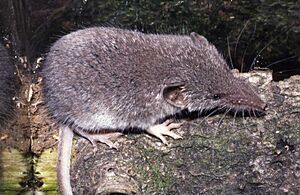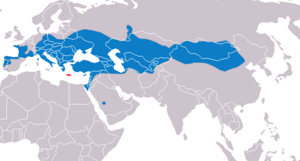Lesser white-toothed shrew facts for kids
Quick facts for kids Lesser white-toothed shrew |
|
|---|---|
 |
|
| Conservation status | |
| Scientific classification | |
| Genus: |
Crocidura
|
| Species: |
suaveolens
|
 |
|
| Lesser white-toothed shrew range | |
The lesser white-toothed shrew (Crocidura suaveolens) is a tiny mammal. It is a type of shrew found in many parts of the world. You can find it in Africa, Asia, and Europe.
These shrews like to live in bushy areas and gardens. They eat mostly insects, but also spiders, worms, snails, and even small newts or rodents. What they eat can change depending on where they live. There's a similar shrew called the Asian lesser white-toothed shrew. It was once thought to be the same species, but now scientists know it's different.
Just like the common shrew, a mother lesser white-toothed shrew and her babies sometimes form a "caravan." They do this when they are looking for food or a safe place. Each shrew holds onto the tail of the one in front. This way, they all stay together as a group.
Where Lesser White-Toothed Shrews Live
The lesser white-toothed shrew lives in many places. You can find it from France and Portugal in the west. Its range stretches across Europe and Asia all the way to Japan. It also lives in North Africa.
These shrews prefer dry places. This includes areas with bushes and gardens. On the Isles of Scilly, they even live on shingle beaches and sand dunes. Some groups of these shrews are separated from others. This includes populations on the Isles of Scilly and the Channel Islands. These islands are Jersey and Sark, located off the French coast. A special type of this shrew, Crocidura suaveolens balearica, lives on Menorca. Menorca is one of the Balearic Islands.
Meet the Scilly Shrew
A special group of lesser white-toothed shrews lives on the Isles of Scilly. These islands are off the southwest coast of England. This group was once thought to be a unique subspecies. It was called Crocidura suaveolens cassiteridum, and people know it as the Scilly shrew.
Scientists have studied the skulls and teeth of these shrews. They found that Scilly shrews are a size between those in the Channel Islands. Their fur is a bit darker, but this is not enough to make them a separate subspecies. What's interesting is that these shrews can be found on the islands' beaches. There, they mostly eat tiny sea creatures called amphipods. The local name for this animal on Scilly is "teak" or "teke."
Old bones found by archaeologists show these shrews were on the islands long ago. They were there during the Bronze Age. This means they might have been on the islands before they separated from Europe. Or, they might have traveled from the Channel Islands or Europe on ships.
In 1924, a man named W N Blair found a new type of shrew on Gugh. He sent it to a mammal expert, Mr. Martin Hinton, at the British Museum. This shrew became the official "type" example for the species. Ten years earlier, H N Robinson found a small rodent at Old Town St Mary's. He sent it to Mr. F W Smalley, who had a large collection of rodents.
In 2010, a Scilly shrew became famous on BBC Cornwall. It was a stowaway on the passenger ferry RMV Scillonian III. The crew found the shrew just as the ship was arriving in Penzance. The very next day, the shrew flew back to the Isles of Scilly. It traveled on a Skybus plane. Then, it was set free back in its home environment.


